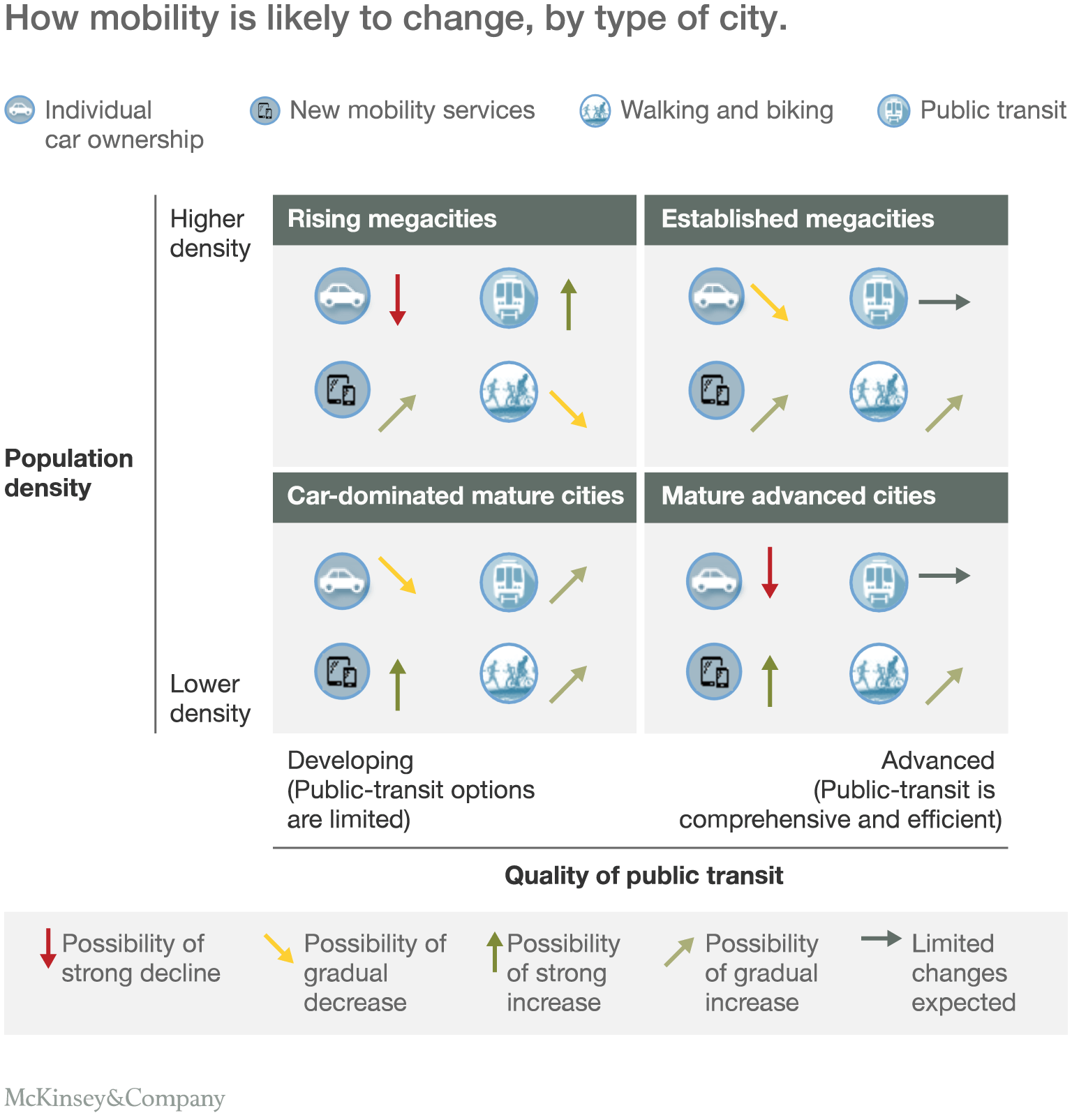Cities move. People hurry from corner to corner; cars and trucks roll along the roads, while bicycles and scooters jostle for space.
But sometimes that movement falters, and with it the dynamism that is the hallmark of great cities. Unhealthy smog levels and traffic jams, with their chorus of horns and shouts, are routine irritations of urban lives, and things could get much worse. The world’s cities are facing an urgent set of challenges when it comes to ensuring that fundamental rite of urban living: getting around.
By 2030, 60 percent of the world’s population will live in cities, up from about 50 percent today.1 Over the same period, more than two billion people are likely to enter the middle class, with the majority of them living in cities in emerging markets, particularly China. The number of megacities with more than ten million people will continue to grow.
Many people entering the global middle class will want to buy cars: automobile sales are expected to increase from about 70 million a year in 2010 to 125 million by 2025, with more than half forecasted to be bought in cities. Some automotive analysts have gone as far as predicting that on the existing trajectory, today’s 1.2 billion strong global car fleet could double by 2030.2
The existing urban infrastructure cannot support such an increase in vehicles on the road. Congestion is already close to unbearable in many cities and can cost as much as 2 to 4 percent of national GDP, by measures such as lost time, wasted fuel, and increased cost of doing business. Transport creates emissions of greenhouse gases; smog presents serious public-health concerns. The World Health Organization estimated in 2014 that seven million premature deaths are attributable to air pollution, and a significant share is the result of urban transit.3
However, the future does not have to be this way.
Solving the mobility challenge will require bold, coordinated actions from the private and public sectors. Technological advances and commercialization, funding, intelligent policies, and business-model innovation will be needed to realize productivity improvements while creating more sustainable environments in our cities. We are optimistic that this will help the world avoid a future of global gridlock. Already, there is discernible movement toward new “multimodal” services—those that facilitate journeys combining walking, cars, buses, bikes, and trains—as well as shared transportation services.
While many of the technologies and business models we highlight are being introduced in more affluent countries, these trends are also relevant for emerging economies. Cities such as Beijing, Jakarta, and Moscow are already suffering from overwhelming congestion; they could leapfrog the transit paradigms established in the 19th and 20th centuries by adopting new technology, urban planning, and business models.
The speed and extent of the mobility transformation will differ. In this report, we lay out a framework that describes the evolution of urban mobility. We also highlight a set of urban archetypes, defined by population density and the maturity of public transit; each archetype can be expected to take a different path to mobility. Our analysis suggests that a mobility revolution is on the way for much of the world. As a result, we anticipate big improvements in the quality of life for city residents.
Welcome to the urban-mobility revolution.
Approaching the tipping point
Understanding how a city’s mobility system will evolve is complex. We have developed a framework (Exhibit 1) to help stakeholders understand underlying forces and how they interact; on this basis, they can begin to design and implement the appropriate interventions. In this section, we look at seven factors that are essential to keeping cities moving cleanly and efficiently.

Privately owned vehicles
Four major technological trends are converging: in-vehicle connectivity, electrification, car sharing, and autonomous driving. If cities can figure out how to make these elements work together, mobile-productivity solutions could be substantially improved.
In-vehicle connectivity: The broad adoption of in-vehicle connectivity, either through the mobile phone or through an embedded system and screen, is opening up possibilities. For example, real-time analytics and data on traffic conditions can reroute drivers to avoid congestion; there are apps that offer information allowing people to shift the timing and route of travel. Eventually, vehicle-to-vehicle and vehicle-to-infrastructure communication could be used to reduce accidents and to anticipate traffic congestion.
Software will play a critical role in optimizing traffic flows. Information would travel in many directions, so that traffic-control centers could get detailed intelligence from cars, for example, to clear bottlenecks faster by alerting drivers so that they can avoid congested areas. For example, Waze, a mapping app that crowd-sources traffic data, has partnered with a number of cities, including Barcelona, Boston, Jakarta, and Rio de Janeiro, to integrate its data into the city’s intelligent-transportation system traffic-control center. Drivers get detailed, user-generated real-time data, enabling them to avoid bottlenecks, while cities can use information on traffic conditions to respond to emerging situations.4
Electrification: IHS, a market-research firm, predicts that annual sales of battery-powered electric vehicles (EVs) and hybrids will increase from about 2.3 million units in 2014 to 11.5 million by 2022, or 11 percent of the global market. Electric power trains can significantly increase the energy efficiency of the car while decreasing the pollutants emitted. While shorter-term forecasts of EV sales remain significantly lower than their less expensive fossil-fuel counterparts, Tesla has demonstrated that electrification could penetrate certain market segments. This dynamic could be stronger in cities, where driving distances are shorter and people are less worried about running out of power. In addition, battery costs are falling faster than even the most optimistic predictions, so the economic trends are shifting in favor of EVs in the mid- to long term.
Car sharing: Most cars sit idle 90 percent of the time or more. Car sharing and other services could improve this figure significantly, and perhaps reduce the number of cars on the roads at the same time. While the effect of car-sharing on rates of car ownership is still being studied, there is little argument that widespread car-sharing would mean each vehicle gets used more intensively, thereby increasing its annual mileage from 11,700 to 20,400. Extrapolating further, shared, fully autonomous vehicles could lower the cost of personal mobility by 30 to 60 percent relative to private auto ownership.
Car manufacturers, together with technology companies, are gearing up for this revolution. Daimler launched Car2Go, a car-sharing system, and BMW has DriveNow. Daimler has noted that services like Car2Go “can be made even more flexible and sustainable with the help of autonomous-driving functions.”5
Autonomous driving: In recent months, autonomous vehicles (AVs) have captured the imagination of the media and the public. The introduction of fully autonomous or driverless vehicles is approaching. Some new luxury-car models already feature sophisticated driver-assistance systems offering a degree of autonomy. However, it is difficult to predict how fast autonomous cars will make their way into the marketplace, especially given uncertainty about regulation. Google has said that it plans to launch a pilot of a fully autonomous car by 2020—and perhaps as early as 2017.6 Uber, the San Francisco–based e-hailing firm, is working with Carnegie Mellon University to create the Uber Advanced Technologies Center, with a view to building AVs for use in its fleets.7
By reducing the human factor behind the wheel, autonomous vehicles could cut accidents by as much as 90 percent, according to preliminary estimates, saving thousands of lives and up to $190 billion a year in the United States alone by 2050.Autonomous driving could also increase the carrying capacity of roads because vehicles would be able to travel closer together and at higher speeds. Ultimately, driverless vehicles (defined as 100 percent autonomous driving of a vehicle without an actual driver to override the system), could free up time for passengers to do other tasks, or chauffeur people who cannot otherwise drive themselves.
These are exciting prospects, but without significant deployment and penetration of EVs, car sharing, and supportive regulations, the advent of AVs will not, by itself, be sufficient to solve urban air pollution and congestion problems. Also, the convenience of driverless cars might increase vehicle miles traveled. Commuters who take the train so that they can read or catch up on e-mails would be able to do so even more conveniently and comfortably in their own cars. Can’t find a parking space? Ask the car to circle the block while you eat dinner.
Walking and bicycling
Pedestrian zones are not new. There are many examples of city centers, such as Venice and the medieval city of Mdina, in Malta, that have never allowed motorized vehicles. Mdina is even known as the “Silent City” because of the absence of motor-traffic noise inside the city walls. Pedestrian zones in Japan are called hokōsha tengoku, which translates as “pedestrian heaven.” Parts of the Calle Florida in Buenos Aires have been restricted to pedestrians since 1913 and the whole street since 1971. More recently, many cities have moved to pedestrianize parts of their city centers. Examples include London, New York, Paris, and Singapore. These efforts often include not only restricting access to cars but also making the streets themselves more attractive to pedestrians by installing better lighting, street signage, and paving materials and adding more greenery. Other cities are experimenting with closing certain streets on weekends; for example, a portion of Central Jakarta is closed on Sunday morning to allow residents to exercise.
These efforts can have positive implications for urban mobility. Forty years ago, traffic was terrible in Copenhagen. Not anymore. The Danish capital introduced its first car-free zones in the 1960s, and the city has added many more since then. Transport authorities created a network of bicycle lanes as well as dedicated bicycle highways that reduce traveling time and improve safety.
In fact, cities around the world are opening car-free zones to pedestrians and bikers. In addition, many cities are trying to make bicycling safer, easier, and more popular. Bike sharing in particular has hit the mainstream. In 2015, more than 850 cities had such programs, up from 68 in 2007. In 2015, there were more than a million bikes in bike-sharing programs globally.
London is building 12 “cycle superhighways”—extra-wide lanes dedicated to bicycles. New York expects to have 1,800 miles of bike lanes by 2030. Paris has a bike-sharing network that includes the suburbs and is integrated into the public-transit payment system; São Paolo is doing the same. Delhi is considering proposals to set up separate bike lanes and is providing bike parking near transit stops. Moscow is expanding bike sharing and adding dedicated bike lanes. San Francisco is expanding its network of bicycle lanes; the city’s goal is to increase the percentage of all trips taken by bike from 3.4 to 10 percent by 2018.
Companies in Silicon Valley are piloting electric bikes as a means of commuting. At one major technology firm, more than 10 percent of employees bike or walk to work, and half live within ten miles of the office. A ten-mile commute by car takes about 30 minutes door to door. By bicycle that would take about 60 minutes; by e-bike, though, it would be only 35 minutes, which makes it an attractive option. Getting employees to bike to work is worth real money; each parking space that can be saved on corporate campuses is worth $10,000 to $20,000.
Although biking is growing fast, it is from a low base. In the United States, bicycle commuting for the 50 largest US cities increased from 0.6 percent in 2000 to 1.0 percent in 2008 to 2012. In New York City, for example, bicycle commuting has more than tripled since 2000 but still represents only a little more than 1 percent of commuters; in Amsterdam and Copenhagen, the comparable figures are 38 and 26 percent, respectively. In some cases, the trend is in the other direction. In a number of Asian cities, bicycling’s share has declined as newly affluent consumers have bought motorbikes and then, eventually, cars. In Beijing, bicycles accounted for 63 percent of trips in 1986; by 2012, that was down to 14 percent.
Public transit
Cities worldwide are pouring investment into public transit as a way to improve mobility.
Bogotá is well known for the TransMilenio bus rapid-transit (BRT) system, with its dedicated bus lanes, elevated bus stations, smart-card payment, and beautiful red buses. The TransMilenio BRT, which had 70 miles of service in 2012, is aiming for 241 miles by 2016.8 Beijing has added more than 230 miles of subways in the past seven years.9 Dubai launched the 32-mile Red Line in 2009, and the Dubai Roads and Transport Authority’s master plan includes 262 miles of metro lines by 2030.
Developed cities are also investing in public-transit improvements. San Francisco is planning to extend the Caltrain to reach the center of the city, upgrading the commuter-rail system, and introducing bus rapid transit along select corridors. Washington, DC, continues to expand its metro system into the suburbs and is installing dedicated bus lanes. Light rail is making a comeback in some parts of the United States. In 2014, there were more than two dozen light-rail projects under way in the United States.10 Portland, Oregon, for example, expects to open the 7.3-mile Orange Line in September 2015.11
Cities are also starting to digitize their public-transit systems and are trying new mobility-on-demand models; think of one seamless app that consolidates all modes of transport including public transit. Helsinki, which already has good public transit, will bear watching. It is developing an ambitious on-demand mobility program that aims to make personal cars unnecessary by 2025.12 Under its new Mobility as a Service (MaaS) action plan, consumers will be able to use mobile apps to book and pay in one click for any trip by bus, train, taxi, bicycle, and/or car sharing. Helsinki is working with the private sector to develop and test the technology and cofinance the operation. In Santa Clara, California, the Valley Transportation Authority (VTA) has opened its Innovation Center, where VTA teams, companies, start-ups, and students can develop new transportation-related technology.13 The private sector is bidding to develop a software solution that would enable VTA to build new transit on demand and subscription-based transit models.14
New mobility services
A wide range of mobility services offers new kinds of transportation alternatives (Exhibit 2), and money is pouring into the sector (Exhibit 3). In 2014, global venture-capital investments into mobility services amounted to more than $5 billion, up from less than $10 million in 2009. Besides Uber, China’s Didi Dache, which has more than 100 million users in 300 cities, raised more than $800 million and Ola, India’s biggest online cab service, has raised $677 million so far.


These new mobility services and product concepts could profoundly change both public and private transit (see sidebar “San Francisco and the economics of travel”). Of course, not all of these start-ups will survive, but the technology, business models, and user experiences will likely improve. We are confident of this because consumers have proved remarkably receptive to using many of the new mobility models. For example:
E-hailing: Uber is already operating in more than 300 cities and 58 countries, and in some of them, it is already larger than the traditional taxi industry. In China alone, an estimated 170 million people use some form of e-hailing services.15
Car sharing: These services are growing 35 percent a year in the United States, reaching 1.6 million members in 2014. In Germany, car-sharing membership has grown 50 percent a year since 2010, reaching 1 million people in 2014.
Shared e-hailing: Lyft’s CEO, Logan Green, recently announced that the company’s shared e-hailing service, Lyft Line, already accounts for most of its San Francisco business.16 Both Uber and Lyft plan to roll out shared services to new cities in 2015.
On-demand private shuttles: Using smaller, more flexible shuttles is not a new idea; New York City’s “dollar vans” and the minibuses common in the developing world have been around for decades. But the new crop of connected, on-demand shuttle services is finding a loyal customer base and an operating model that is allowing the services to expand to new routes and new cities.
Private buses: Some private employers, such as Google, Apple, and Genentech, are building transportation networks for their employees. This is happening in the developing world too. Tata Consultancy Services has more than 225 buses to help its employees cope with the notorious traffic jams in Chennai.17
Software companies are also getting involved in improving transport. Apps like Moovit allow consumers to plan their journeys by stringing several trips together in the most efficient way. Waze reroutes travelers away from heavy traffic. Urban Engines uses real-time consumer travel data to help public-transit agencies visualize, analyze, and improve public-transit network performance. Firms like TransLoc and RideCell are helping agencies to optimize and automate their operations by developing technology platforms to help them integrate flexible, on-demand services that can supplement their traditional high-occupancy, fixed-route fleets.
New and improved mobility services are making transportation ever more multimodal, on-demand, and shared, increasing consumer choice and convenience (Exhibit 4). One consequence is that the overall transportation system, including fleet management and traffic-control centers, will become more digital and therefore more efficient by better matching demand and supply in the short and midterm because of improved data and analytics capabilities. Another is that public transit will likely face competition from new private-transit approaches.

Which of these mobility services and underlying business models will survive and scale up remains to be seen. The key is that the economics need to be sustainable; that means that providers have to ensure that operating expenses and services are competitive. Consumers will be choosing from a range of options; convenience and cost will therefore be critical factors. The market will weed out services that fail on those counts.
Policies and regulations
Urban-policy decisions made today will determine how mobility and car usage evolve in the next 10 to 20 years.
Having reviewed the long-term transportation plans of more than 25 major cities, we believe there is a clear trend to create incentives that make public-transit, biking, and shared-transportation options more available and attractive. For example, London, Singapore, and Stockholm have had congestion charges for years, and they have worked as intended, decreasing and smoothing out traffic. In the long term, new technologies could allow more cars on the roads, with less congestion and pollution. Carmakers that invest in EVs and AVs may be in a position to take advantage of that long-term trend.
In the shorter term, some cities seeking to curb congestion and pollution are considering limiting the number of cars, for example, by restricting parking (or making it more expensive), and creating car-free zones. A number of Chinese cities, including Beijing, Guangzhou, Shanghai, and Tianjin, limit the addition of new cars by auctions or lotteries for new license plates. Some Chinese cities also restrict cars with nonlocal plates.18 Milan has the same goal but is going about it differently; the industrial capital of northern Italy is granting free public-transit vouchers to commuters. An Internet-connected box on the dashboard keeps track of a car’s location, so no one can cheat and drive to work.
Emerging products and technologies, such as EVs, AVs, and connectivity, could help to curb pollution and congestion, but new players may not have an easy time getting into the game. E-hailing firms, such as Uber or Lyft, are facing regulatory challenges to their business model, while car-sharing operators have to negotiate deals with cities to get permits to operate and to use public parking spaces. The biggest hurdle for AVs to be adopted at scale may not be technological, but rather in the definition and harmonization of regulations at a city, state, national, and even international level.
Solving regulatory challenges is not easy. Companies such as Uber and Lyft, for example, are formidable competition to the existing taxi industry. In June 2015, Paris taxi drivers blockaded traffic and access to airports in protest of UberPOP. Other new mobility measures are also controversial; drivers in many cities are not happy about having to make room for bicycling lanes. Trade-offs are inevitable, and difficult; while many mobility innovations make sense in theory, politics will make accommodating them exceptionally challenging.
So important is the regulatory environment that major transportation firms and start-ups today have sizable public-policy departments. These firms have hired former lobbyists, regulators, lawyers, public-relations experts, and economists in the hope that doing so will enable them to continue to operate and to shape regulation that supports their business models.

Voices on Infrastructure, Number 3
Land use and urban design
How land is used and how cities are designed helps to determine what kind of transport is used: single-family homes on large lots increase the need for cars, whereas high-rise apartments (with limited parking) create the conditions for people to choose to use subways, buses, or taxis.
In the United States, for example, the rise of the automobile during the 1950s, 1960s, and 1970s allowed people to move out of cities into bigger houses in the suburbs. In addition, zoning codes separated residential, commercial, and industrial areas, meaning that people needed to drive to work and to shop. This model makes it difficult to offer public-transit cost-effectively, and large parts of the United States are public-transit deserts. No wonder the United States has the highest ownership rate in the world, at 1.93 vehicles per household.19
In contrast, many European cities developed their urban cores before the invention of the automobile. Hence, they are denser, more walkable, and more likely to have mixed uses. As a result, there are lower rates of vehicle ownership and fewer miles traveled by car.
Urban planners are increasingly taking these factors into consideration in the way they design cities. In many emerging economies, cities are still very much in evolution; designers are in a position to make choices to promote compact, transit-oriented, and sustainable cities. Outside the ancient capital of Chengdu in southwest China, for example, a new satellite city is being built for 80,000 people that could serve as a model for a modern suburb. Instead of a layout that makes it necessary to drive, the streets of what will become Tianfu District Great City are designed so any location can be reached in 15 minutes on foot. Motorized vehicles will be allowed on only half the roads; the rest are for walkers and cyclists.20
Tianfu is an example of transit-oriented development (TOD)—high-density, mixed-use urban environments with easy access to mass transit. Such developments have environmental benefits in the form of fewer greenhouse-gas emissions, as well as less air and noise pollution. They have less congestion and therefore fewer accidents; they can also be remarkably livable and attractive to residents of all ages.
While implementing TOD is simpler if planners are starting from scratch, as in Tianfu, older cities can also adapt these principles. For example, in the Boston area, until the early 2000s, the train line running between the central business district and the southern outskirts of the city had only three stops, leaving some of the most densely populated and poorest city regions three miles (more than 4.8 kilometers) from the nearest station. The Massachusetts Bay Transit Authority therefore added four new stations, and communities along the route have seen new life in the decade since completion, resulting in 1,500 rebuilt housing units, the development of 780,000 square feet (72,500 square meters) of commercial space, and 1,300 jobs.21
Consumer preferences and behaviors
Mobility has a number of substantial benefits, such as access to jobs and a sense of personal freedom. But the way it is now also carries with it persistent challenges, such as costs and congestion.
We are still in the infant stages of new mobility offerings. What can be said is that consumers are learning to make trade-offs when it comes to evaluating costs, convenience, service, and time.
New technologies can change behavior, and this may be happening when it comes to transport. Smartphones are already ubiquitous in developed countries and are spreading fast in many middle- and lower-income ones. That has enabled companies like Uber or China’s Didi Dache to offer on-demand mobility through apps. Other apps (see sidebar “Start-ups that are reimagining personal mobility”) make it possible for travelers to plan in real time the quickest and cheapest way to get from point A to point B.
In developed countries, there are subtle hints that consumer preferences and behaviors are changing. Even in the United States, where the love of the car runs deep, ownership rates are declining and drivers are driving less (Exhibit 5).

Declines in car ownership are most pronounced for the millennial generation (those born between 1980 and the mid-1990s). Surveys have found that American millennials are 16 percent less likely to commute by car to work, use public transit almost three times more often, and are 23 percent less interested in owning a car than the generation that precedes them. They are also more likely to use shared transportation services like car sharing and e-hailing. In Germany, car-ownership rates among 18- to 29-year-olds have dropped sharply, from 420 cars per 1,000 people in 2000 to 240 in 2010.22 Still, further research is needed to understand whether millennials in the West are merely delaying car ownership or whether these attitudes represent a new normal.
Moreover, there are countervailing trends. In many developing countries, such as Brazil, China, and India, the desire to own a car is strong, and ownership continues to grow. Without new policies and priorities, they are likely to follow the same path much of the developed world did in the 20th century, with similar challenges relating to pollution and traffic. The difference is that these markets have options and can benefit from experience, tapping into new services and technologies to cope with these issues in a timely manner. Ultimately, we need to better understand various consumer segments and their attitudes toward car ownership and mobility.
What kinds of cities will lead the mobility revolution?
Cities will not develop in parallel. The pace of transformation is going to differ; the forces at work are not the same.
But some cities are similar and therefore face common challenges and opportunities; they can learn from one another’s experiences. It’s helpful to think of them by measures such as how densely populated they are and the state of their public-transport systems. On that basis, there are four types of cities that are particularly worth watching when it comes to urban mobility. In each archetype, policies, technology, consumer preferences, and business-model innovations will play out in different ways (Exhibit 6).

Established megacities
This group comprises large, prosperous cities that are densely populated, with relatively low car ownership and well-functioning public-transportation networks—places like London, New York, and Tokyo. Many of these cities are adopting new ways to manage traffic, such as congestion charges, parking restrictions, bike lanes, and car-free zones. In addition, new mobility services are already taking off in a number of established megacities. The result is likely to be reduced reliance on individually owned vehicles—but possibly less public-transit usage in favor of more convenient private-transit options.
Rising megacities
Mexico City, São Paolo, and Shanghai: in these and other middle-income cities, cars are a status symbol that millions want—even though the urban infrastructure is ill equipped to cope with demand. Pollution in Beijing sometimes hits 35 times the recommended safety levels; traffic jams in São Paolo can last for hours. At the same time, though, public transit is improving, and many cities are taking action to reduce vehicle usage and ownership. Moscow is seeking to curb traffic by improving the subway and making mass transit more convenient. Initial efforts along these lines have already visibly reduced congestion. Better usage of space and improved connectivity could ease congestion; more EVs could mean less smog. Will this be enough? That will depend on how fast, and how deep, these measures penetrate the market.
Mature, advanced cities
These are similar to established megacities in that they are prosperous and feature good public-transport systems. However, they tend to be smaller (think Helsinki); they are also predominantly European, though not exclusively. These cities are making conscious efforts to shift residents toward public transit, biking, or walking. Vienna is implementing a transportation system that expands public transport and builds more bike lanes. Vancouver is investing heavily in separate bike lanes, implementing variable pricing to incentivize off-peak commuting, and promoting employment along existing transit corridors. In both cities, these measures will reduce pollution and traffic, while improving safety and quality of life.
Car-dominated, mature cities
Most large US cities, particularly those that developed in the second half of the 20th century, fall into this category.
Such cities face a challenging situation. Past decisions have established a status quo that requires individual car ownership to get around, which makes fundamental change difficult. That said, heavy traffic, long commutes, and environmental concerns may be creating the conditions for people to think about alternative ways to get around. The most disruptive potential may come from connected driving. People will not easily give up their cars, but as a result of connectivity, those who have them will drive on safer roads with smoother traffic, reducing commute times and congestion. In more immediate terms, e-hailing companies are already operating all over the United States, and services such as car sharing and on-demand shuttles, while small today, have found consumer acceptance, which is the key to getting bigger.

Would you like to learn more about the Global Infrastructure Initiative?
Keeping pace
The biggest winners in the mobility revolution will be consumers, who will have many more ways to get around—and these modes could also be cheaper and faster, with customized levels of service and convenience.
Incumbent industries should watch for significant shifts in existing profit pools as new technologies and business models gain share—witness the impact e-hailing has had on the taxi industry in some cities. This means incumbents need to craft effective strategies sooner rather than later. Moving slowly at the start and not considering the spectrum of mobility services and consumer segments could mean losing the race entirely.
And there may also be unintended consequences. For example, while private, on-demand shuttles may encourage more people to take advantage of alternative forms of transit rather than drive to work, these services may also compete directly with public transit, eroding ridership and making public transit less economical.
Collaboration is essential in the new-mobility economy. Mobility services, for example, will need to find partners to provide the technology to power their businesses. Manufacturers will need to work with insurance firms to develop new products for autonomous vehicles. And there are times when competitors will also find it necessary to collaborate, as Lyft and Uber do when dealing with regulators. For their part, regulators may find they need to consider how to use new technologies to broaden consumer choice and improve urban environments, especially reducing congestion and pollution. That may require rethinking rules written for a different era and redeploying city spending that has historically tended to favor more roads and highways—a difficult task, but one that will be crucial in how fast mobility innovations get traction.
The road ahead
One thing is certain: given rising incomes and aspirations, there will be more demand for mobility. That will stress the world’s infrastructure, as well as its nerves.
Today, transportation in many cities (and almost all suburban and rural areas) requires owning a car; other options are either insufficient or simply not available. But new technologies are reshaping the game—everything from apps that make it easy for car owners to rent their vehicle to e-hailing and ride-sharing services (see sidebar “Start-ups that are reimagining personal mobility”). The availability and integration of increasing types and amounts of data will substantially increase the share of trips that are multimodal.
So, what will the future of urban transit be? Our view is that it will be more on-demand, with more sharing, and will provide a broader spectrum of services. Autonomous vehicles may be feasible, in both technical and regulatory terms, and faster than commonly expected for certain trip types. Urban mobility will likely be lower cost, faster, and safer, and the lines between private and public transport will be increasingly blurred.
Regulators in many parts of the world are actively working on policies that support the massive wave of change sweeping the mobility landscape. The United States, for example, is working on a framework to govern autonomous cars. Our analysis shows that the cost of the components required for fully autonomous driving—meaning drivers don’t need to touch the wheel—are both lower than many people believe and declining rapidly. Innovation in connectivity, autonomy, lightweight materials, EVs, and AVs will continue to accelerate, and the attitudes of citizens and cities around the world are evolving. Put it all together, and we can’t help but be excited about the bright future ahead for urban mobility.





